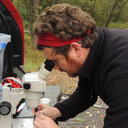Characterization of excretory-secretory products from protoscoleces of Echinococcus granulosus and evaluation of their potential for immunodiagnosis of human cystic echinococcosis.
Ключавыя словы
Рэферат
This study describes, for the first time, the characterization of excretory-secretory antigens (ES-Ag) from Echinococcus granulosus protoscoleces, evaluating their usefulness in the immunodiagnosis of human cystic echinococcosis. ES-Ag were obtained from the first 50 h maintenance of protoscoleces in vitro. This preparation contained over 20 major protein components which could be distinguished by 1-dimensional SDS-PAGE with apparent masses between 9 and 300 kDa. The culture of of protoscoleces from liver produced a greater variety of excretory-secretory protein components than those from lung. Determination of enzymatic activities of secreted proteins revealed the presence of phosphatases, lipases and glucosidases, but no proteases. These findings were compared to those obtained from somatic extracts of protoscoleces and hydatid cyst fluid products. Immunochemical characterization was performed by immunoblotting with sera from individuals infected by cystic echinococcosis (n = 15), non-hydatidic parasitoses (n = 19), various liver diseases (n = 24), lung neoplasia (n = 16), and healthy donors (n = 18). Antigens with apparent masses of 89, 74, 47/50, 32, and 20 kDa showed specificity for immunodiagnosis of human hydatidosis. The 89 and 74 kDa components corresponded to antigens not yet described in E. granulosus, whereas proteins of 41-43 kDa and 91-95 kDa were recognized by the majority of the non-hydatid sera studied.


